Environment, population and the state – ethical considerations - by Jill Quirk

This talk covers the environment, human population, and the State- with reference to ethical considerations. The world’s population needs to be allowed to decline and then stabilise at lower and safer levels as soon as possible to minimise human suffering. People need to have enough self-governing power to be able to veto the engineering of population numbers upwards by governments and big business. Compromising the environment for economic and population growth erodes human rights and then the humane treatment of other creatures becomes even less likely thus increasing total suffering. [Article adapted from a speech by Jill Quirk of Sustainable Population Australia, Victorian and Tasmanian Branch to the Victorian Humanists, on 25 April, 2014.]
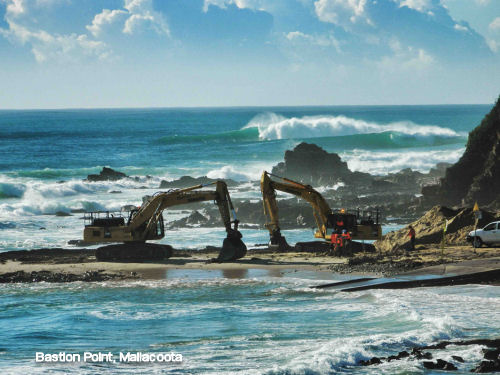
Definitions:
Environment: The place and the medium in which we and our fellow creatures live. It covers the land surface and underneath the earth, the sea, rivers and lakes and the Earth’s atmosphere. One can think of all life, including humans as being an intrinsic part of the environment.
Human population: Homo Sapiens – (a type of ape) their numbers, locally and globally and their movement from one place to another.
The State: All citizens of a place identifying as a unit/country. It is an abstract concept. Note that The State is not the government and governments act within the State.
Ethics
Ethics, is a branch of philosophy that involves systematizing, defending and recommending concepts of right and wrong conduct, often addressing disputes ofmoral diversity.[…]Philosophical ethics investigates what is the best way for humans to live, and what kinds of actions are right or wrong in particular circumstances. (Wikipedia)
So ethics is to do with acting in right and wrong ways – which is usually a decision to be made with respect to others, how we treat them and how we affect them. I will say that at the its most minimal it is about not doing harm or causing suffering and at its most elevated, it is about doing good for others and improving a situation for them or righting a wrong if it is within our powers.
Environmental ethics
Environmental ethics is the part of environmental philosophy which considers extending the traditional boundaries of ethics from solely including humans to including the non-human world. (Wikipedia )
Background
The rock called Earth spinning on its axis and travelling on its orbit around a star we call The Sun is all we have and know as a place to live and survive in. (despite recent discovery of the Earth-like planet 500 light years away) Earth’s environment, the crust and atmosphere as well as the life thereon is deteriorating on every measure one can think of e.g. (globally) - forest cover, climate change, water quality, desertification, biodiversity loss, extinctions and contamination from nuclear oil spills.
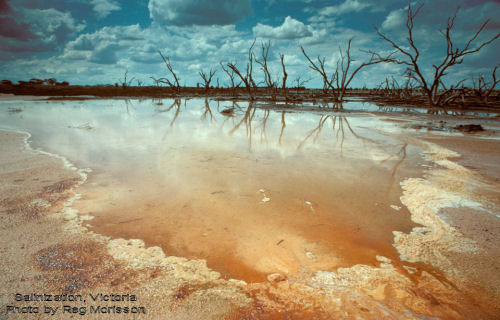
The island continent of Australia suffers many of these problems and more e.g. salinity of soils, deteriorating coastal areas, damage to coral reefs and world record biodiversity loss. Humans are causing all of this destruction either directly or indirectly, inadvertently or deliberately.
This may seem a series of very extreme assertions but unfortunately, I doubt that they can be shown to be wrong.
Population
Human numbers have increased dramatically over the last 300 years from 1 billion to over 7 billion and continue to increase.
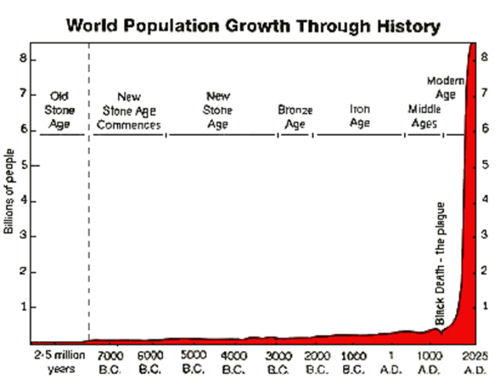
This growth in numbers took off in Britain after the beginning of the Industrial revolution when industrialisation fuelled by the use of coal meant that farm work now done largely by machines displaced peasants from the land to live in the cities and work in factories. This movement of people began the urbanisation process we see continuing in many other countries today. It is a process where people who previously lived amongst other people they knew in a familiar landscape and married not too far from where they were born, found themselves without their familiar references. This sparked off a population explosion. After all in a crowded city of strangers there are no holds barred on permitted marriage opportunities. This is a vastly simplified sketch of the situation- you can read more in Demography, Territory and law by Sheila Newman
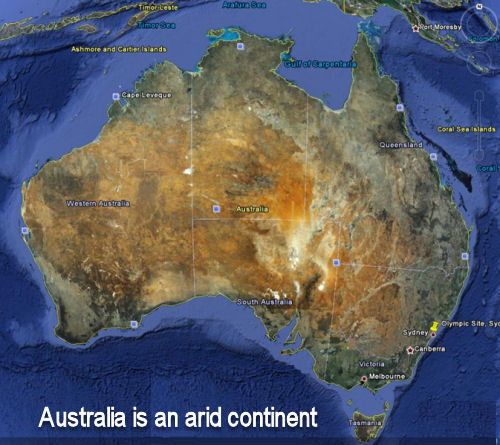
The people of many lands far distant from Britain suffered terribly from invasion as a result of this. The furthest habitable continent, a largely arid and infertile place now called Australia was at this time, home to up to 3 million people (The Australian Aborigines) and had been for between 40-60 thousand years. (Estimations of how many Aborigines lived in Australia prior to European occupation vary between 300,000, through 1.3m to 3m. The largest estimate is by Jim Poulter. See "The smallpox holocaust that swept Aboriginal Australia - Red hot echidna spikes are burning me"
From all accounts the Australian Aborigines had been living in fairly constant numbers in a logical distribution, according the fertility and rainfall patterns since they established themselves on this continent. These patterns were much as the distribution of the human population today but in far fewer numbers. It was not a nation as we know them today but a series of different nations within the continent.
Thus as there was a population explosion in Britain, in Australia, life went on as usual…….Until the unwitting inhabitants sorely and most unfairly felt the consequences.
The Britain and Australia comparison is a stark example of how human populations grow at different rates at different times and in different places on Earth.
The world’s population now grows at about 80 million per year but the growth is not evenly distributed.
Globally Australia’s growth is higher than just over half the nations of the world. It has the highest population growth in the developed world, hovering around 1.8% p.a., doubling each 39 years (according to ABS statistics). Compare this with France at around 0.4-0.5% p.a. (doubling in 140 years).[1]
Government influence over population growth within a state.
Government policies can radically affect a nation’s population trajectory.
These largely come down to
1. The presence or absence of “Pro- natalist” policies-eg.rewards for having babies and
2. High or low immigration policies.
Australia’s rapid population growth is very much influenced by government policies, especially immigration. 60% of Australia’s population growth is from this source. John Howard as Prime Minster greatly increased immigration levels and this was continued by PMs Kevin Rudd, Julia Gillard, and Tony Abbott.
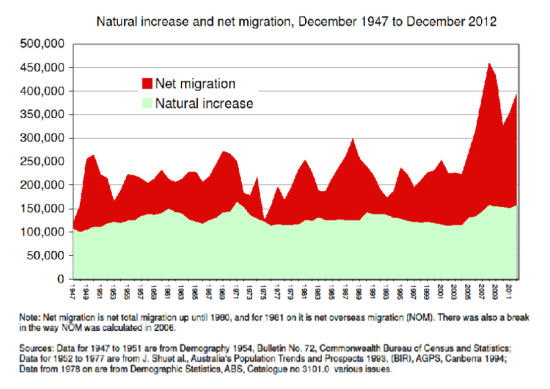
Note low immigration under Gough Whitlam
Population engineering propaganda
Peter Costello, Federal Treasurer
Past treasurer of Australia, Peter Costello, in 2004 urged young families to have “one child for Mum, one for Dad and one for the country”. At this time as it is now, Australia’s population was growing at well over 100,000 p.a. (now about 150,000) from “natural increase” alone births over deaths) quite apart from immigration. But Peter Costello pretended that only immigration was keeping Australia growing!
Costello wrote in a Foreword to The Australia Day supplement for the Sydney Morning Herald, 2006, that "Our national fertility rate (1.75 babies a couple) is less than the replacement level. Only immigration is making our country grow."
In fact, Australia grew by 237,100 people at a rate of 1.2%. Natural increase contributed 127,000 and NOM 110,101. Thus natural increase contributed 53.6%. [And now it is only 40%)
Steve Bracks, Victorian Premier
Around the same time, Victorian premier Steve Bracks, on ABC radio announced that Victoria had more deaths than births. Anyone can make a mistake but to deliberately say such a thing when the complete opposite was true needed a retraction. I wrote to the premier giving him the true recent figures for Victoria (62,000 births and 33, 200 deaths = 28,800 net increase) but I never received a reply. I sent a copy to the then state opposition leader, Robert Doyle who replied, acknowledging that I was correct and that his opposite number was wrong. I am sure it gave him pleasure to write this!
Peter Costello anyway wanted even more births than the Australia wide huge surplus (births over deaths) that we already had and the Baby Bonus was born. [2]
In Australia after the introduction of the Baby Bonus the number of births went from 254,246 in 2004 to 265,949 in 2006. Up by 11,703. That is not to say that the baby bonus was 100% responsible for this increase as other factors could have influenced it. E.g. Virginia Abernethy’s “fertility opportunity theory” says that people will have the number of children they anticipate that they can raise and thus their fertility will be influenced by their future expectations. This can mean economic news, the expectation of an inheritance, anticipated education expenses, even expressed willingness on the part of grandparents to mind children in working hours.
But the intention of the Peter Costello’s “Baby Bonus” was to increase the country’s human fertility. This is government engineering of the fertility rate.
Australia’s population has gone from 19.2 million in 2000 to nearly 23.5 million now in 2014 and is now the highest growth rate in the OECD, a similar rate to many 'third world' countries.
This number of humans and their activities are damaging Australia’s fragile environment.
What are the ethical considerations?
All of us in this room would probably consider ourselves good, well-intentioned, ethical people. We would not harm anyone we know and we would want the best for all of them. Do we extend our comforting, helpful, improving and not- harming attitude and behaviour only towards one species, our own or do we extend it to our fellow creatures? And should our efforts at not harming but doing our best for the well-being of others be only for those living now or also for coming generations who have no say in decisions made now which affect them?
How do we act, then with respect to ourselves, other people including future generations, other creatures, our environment and our population numbers within the State?
How big is our sphere of influence?
In discussing this we, as individuals need to look at our own sphere of influence. How big is it, really?
At a Nation State level, our sphere of influence is as big as governments and ruling elites within the State will allow and on our level of resources. Most of us can take care of our immediate family but going further than this, to extended family and /or friends requires greater resources. Taking care of the immediate environment where you live and protecting it for your own descendants can be very problematic requiring organisation of other locals and an effective democratic process of self- government. Often people fail to save for future generations the piece of nature that they have enjoyed because of failings in any of these areas.
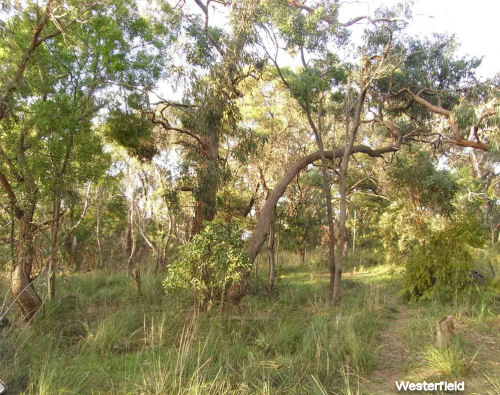

Individuals can spend much of their time and energy trying to save natural areas or an example of Heritage which they value –e.g. Jill Redwood of EEG, the forests of East Gippsland, Julianne Bell, Royal Park, Jenny Warfe, Port Phillip Bay from channel deepening, Gloria O’Connor in Pakenham area saving public assets on public land for the community Sheila Newman and James Sinnamon telling the stories of many of these through an alternative medium candobetter.net. MP Kelvin Thomson devotes enormous energy to saving Victoria’s environment, Ian Bird as a guardian of Carlton heritage etc. Many of these people’s crusades have continued for decades in the face of many discouraging failures.
As David Suzuki said “In the environmental movement, every time you lose a battle it's for good, but our victories always seem to be temporary and we keep fighting them over and over again.”
Effects of lost environmental battles, population growth and development.
There have in fact been plenty of defeats and they are permanent. Just locally, most planning cases at VCAT are lost by the objectors, Lake Pedder in Tasmania was flooded, for hydro-electricity (although the Gordon River area was saved), Port Phillip Bay channel deepening involving massive blasting at the Heads proceeded and it does not stop there. Next it will be the sensitive area of Hastings. Pre- settlement woodland at the Westerfield property was annihilated for the Peninsular Link freeway after sustained and strong community objection. Bastion Point boat ramp at Mallacoota, strongly opposed involving removal of 3,500 cubic meters of rocky reef is going ahead.
The original environments can never be restored.
In Australia, it seems that the citizens’ sphere of influence is small.
The loss of natural areas results in biodiversity loss and suffering of other creatures. When a forest is felled, the inhabitants do not survive. They die painful deaths from, poisoning, starvation, being run over or cut up by machinery. The probable scrapping of the Forests Peace Deal in Tasmania will, undoubtedly increase this destruction and suffering on an island that is world heritage famous for its forests.
The benefits of logging for the bulk of Australians are very dubious but those opposed to logging were, it seems only able to get a temporary stay of execution for many of the forests in Tasmania.
None of us would be pleased to know that on every parameter, Victoria’s environment is in decline because of human population pressures but most of us have no say in the level of population growth.
The Commissioner’s forward to the first Victorian State of the Environment report, 2008 says
“Victoria is the most developed state in Australia and its natural environment has been heavily modified from the time of European settlement. This State of the Environment report reflects the simple fact that most areas of the state are highly stressed. Most natural vegetation, waterways, wetlands, coasts and rivers are reported in a parlous condition.”
http://www.theage.com.au/environment/environment-call-to-improve-states-health-20131128-2ye5t.html
Other quotes within the report are :
“Population growth, settlement and consumption patterns and climate change are the key drivers of environmental degradation in Victoria”
“Victoria’s population growth, increasing affluence and the expansion of our cities and towns have contributed unsustainable levels of resource consumption and waste production.”
“Energy generation and consumption is the single largest component of Victoria’s ecological footprint.”
“Consumption drives the modification of our waterways and is an environmental pressure in itself “
The 2013 State of the Environment (SOE) Report reveals that the state of threatened species, energy use and waste generation have all got worse. There is no change in the state of marine and coastal ecosystems or of freshwater aquatic systems. The 2008 report should have put governments on an emergency footing but the environment seems to have low priority otherwise we might have done better.
Population pressures of course continue to increase.
Rapid population growth in Victoria has also led to rising demand for land and thus, relative land scarcity and fast increasing land prices. This in itself brings human hardship with mortgage and rent stress, homelessness and narrowed profit margins for local business.
Other creatures suffer even more from human population growth.
Farm animals
Pressure on land has meant farming has become increasingly intensive with, for example laying hens living their whole lives in small cages, never being able to extend their wings or put their feet on the ground. To put it simply, their lives are hell.
Pigs spend significant portions of their lives in confined spaces, sows giving birth and then feeding their young through metal grates. Pigs in agriculture used to, in the past have some sort of normal life before being slaughtered for our consumption.
Native wild life
The other iconic animal to suffer immensely through human population growth is the graceful kangaroo. Presenter Ali Moore blithely said on ABC radio recently, in defence of their being shot that we could not compare this issue with that of whaling (the topic under discussion) as “we have so many of them.” (kangaroos)
We think there are “so many” because they get in the way of our own activities and population growth. There is actually a dearth of accurate information on kangaroo numbers. Kangaroos occupy land which humans would like to see empty. Around Canberra land is required to be empty to make way for housing, roads and airports for more human population growth because this is a way for the state to get more stamp duty and for property developers and financiers to get more action.
The Federal Minister for the Environment has refused to help the survival of the Southern Brown bandicoot in Victoria on the basis that he is the local member for Flinders where wildlife corridors, previously guaranteed will be annihilated for housing for ever increasing population.
This seems to say that he cannot be objective about his own patch and is to me a case where objectivity or disinterest is not required at all.
The outlook is bleak for our native animals with increasing habitat loss let alone deliberate shooting.
Governments could act to right these wrongs but too frequently, they do not.
Why are these ethical issues?
1.The way we treat our farm animals causes life long suffering. Pressure on land from a rising human population is not an excuse for the terrible treatment of these animals but for commercial interest, people will often do what they can get away with according to the law. If land for these enterprises were in abundance and therefore cheap, laws could more easily be changed and in any case, even the most insensitive famer would not have the need to economise by reducing standards to rock bottom.
2. For our native wild life, losing habitat and being shot or poisoned are both painful and then fatal to the animal. Remaining animals after “culling” i.e. incomplete extermination suffer disorganisation and fragmented families. Young kangaroos are left to die, sexual maturity is then reached too early when older animals are shot and as social animals, kangaroos have no-one to help and teach them to raise their young ref. (Faces in the mob)
3. Animals that die out from habitat loss become very difficult or almost impossible to preserve as a species or to re-introduce to another location if there is one.
Other than the charismatic recognisable faces or feathers of animals such as the Tasmanian Devil and birds such as the Orange Bellied Parrot, biodiversity such as trees, grasses, small bushes , flowers, and micro – organisms, small insects etc. are lost when land is taken over for human activities, particularly with invasive all- consuming constructions such as a roads, dams, housing and shopping centres. When compounded, these losses seriously impact on human welfare too both in a psychological /spiritual sense as well as a utilitarian one. (Bats have an important role in forest regeneration and pollination insectivorous micro bats who keep insect populations, especially mosquitos down.)
4.The loss of species affects future human generations who will never see them and will be deprived of benefits without having a say. Humans living right now are being denied access to and experience of nature. Experience of nature is everyone’s right and our collective responsibility to preserve.
We need access to nature in its entirety, not just to an approximation and simplified version of its former richness. omit?
How are we to act?
No sane, sensitive person would want to leave a poorer environment for their descendants than that which they inherited and have enjoyed, surely? They would not knowingly and purposely put their own descendants in peril because of a ruined environment ….would they?
Most of us are not actually or actively doing this. Neither are we irresponsibly having large families, despite “Baby Bonuses”. Most of us are not actively doing anything towards increasing Australia’s population at a 3rd world rate.
BUT most of us are not doing anything to stop it, either.
Records of Australia soon after European settlement
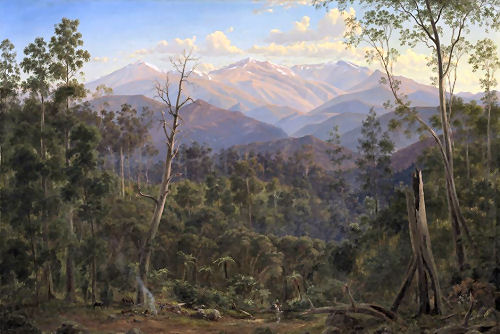
The Aborigines lived on this continent for aeons before European invasion, changing it possibly quite dramatically but not ruining it. They were probably the cause of the “mega fauna” going extinct (as it seems humans were responsible for similar in Europe with the sabre toothed tiger and the woolly mammoth for example) However, the continent was in pretty good shape when Europeans arrived.
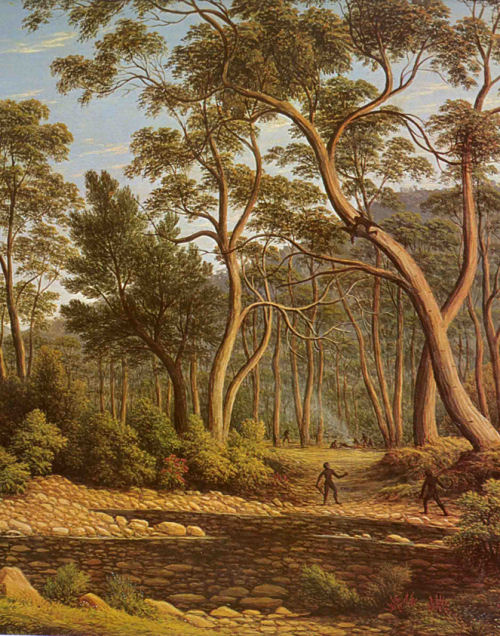
The first -hand descriptions of the lush landscape and wild life in what is now Melbourne are compelling.
Contemporary Australia
We have to admit that by comparison, the area is now a desert and what little is left of nature is on borrowed time because of population growth. Melbourne could be a city of 20 million people and growing by the end of this century if current growth rates continue.
Australia now has a very high rate of population growth, 40% from natural increase and 60% from net immigration. Only a small percentage of immigrants are in the humanitarian intake.
Much of Australia is dry and infertile and cannot be compared with Europe in terms of human carrying capacity as many like to do. Population pressures as well as very intrusive activities such as mining and logging are damaging our environment. Recent high rates if continued would see Australia’s population at over 46 million by the middle of the century.
Why are we either not trying or being singularly unsuccessful in protecting our environment for future generations? Few would argue that this is not an imperative, not just to give future generations pleasure and allow them their birthright but with environmental uncertainties and looming resource scarcities especially oil to actually allow them to survive? Most of us are fairly well- meaning responsible, ethical individuals. So, why is our environment collapsing around us and why are we facing increasing and eventually uncontrollable overpopulation?
I would suggest that it is because we either don’t know how things work or we don’t know how to overcome forces that act against our interests.
What makes it difficult for us to act?
We can observe changes in our immediate environment and in places we visit repeatedly over time but other than our direct experience, we need information.
Insufficient and misleading/partial information
Newspapers, TV, radio on the whole do not give a rounded picture of many issues. This becomes apparent when you have particular specialised knowledge of something and then you read about it in the newspaper and see that the picture given is often unrealistic. Why wasn’t the State of the Environment Report 2008 trumpeted in headlines? I bet most people in this room have not heard of it. The 2013 one showed the overall picture has not improved and in fact is mostly deteriorating. Despite the concern a few decades ago as to what we would do with all the increased leisure we would have with advances in technology, most of us suffer from a lack of time, to seek accurate pertinent facts about issues which affect us or a lack of curiosity and a general inclination to trust mainstream info. Australian Murdoch and Fairfax Mass media have vested interests in population growth, most of which we cannot ascertain. However their investment in property development, finance and sales is obvious. These media corporations own Australia's major property marketing sites: Domaine.com.au and Realestate.com.au .
Subtle censorship
For reasons we all would recognise, it has been very hard to talk about population growth even amongst our friends for fear of sounding politically incorrect. This ridiculous situation has been engineered by the media with vested interests over years and is now virtually unassailable. It is puerile and has silenced us in talking about now and our future. By that I mean the future of everyone permanently living in Australia today.
We have also been censored by the much publicised and unhappy asylum seeker issue. Unfortunate people seeking shelter have been cynically used by governments, starting with John Howard. It was obvious to members of SPA that the asylum seekers arriving in small numbers were being used cruelly as scapegoats and a distraction from simultaneous very high planned economic immigration. John Howard made it official in an interview on ABC RN with Fran Kelly in January this year on the subject of asylum seekers arriving by boat from Indonesia.
He said:
“The more people think our borders are being controlled, the more supportive they are, in the long term of high levels of immigration. Australia needs a high level of immigration. I’m a high immigration man. I practiced that in government, and one of the ways that you maintain public support for that is to communicate to the Australian people a capacity to control our borders and to decide who and what people and when come to this country.”
This tactic, aided and abetted by the mainstream media has given Australians the impression that asylum seekers /refugees = the totality of immigration to Australia and that because many are uninvited they will be treated harshly. In fact refugees/asylum seekers = about 6% of total immigration intake.- The Gillard government increased the refugee quota from 13,750 p.a. to 20,000 p.a Tony Abbott said he would reduce this back to 13,750.
It is no coincidence that the asylum seeker streams are from the countries with whom we are or have been at war: Vietnam, Iraq, Afghanistan, The refugee issue is muddied by both misleading information and censorship which stifle discussion on Australia’s population size. This issue, amongst fair minded people has become self-censoring on population. Some see the government treatment of asylum seekers as conveyed through the media as unacceptable. Others see asylum seekers as a threat are often unaware of the relatively small numbers in the context of a very large, planned economic immigration program and they applaud a tough stance.
Whichever way one is affected by this, one needs to have an idea of numbers to evaluate the situation and to discuss the issue of population in a rational way. It is easier in nearly all circumstances to let the topic drop even though continued high population growth (hardly any from refugee numbers) is damaging.
The issue of the treatment and processing of asylum seekers, their being admitted to Australia and the quotas for refugees is an ethical issue with respect to these people in the context of the number of refugees worldwide and the available places of asylum.
The size of planned economic immigration intakes - is an ethical issue with respect to the incumbent residents of the destination country, their welfare, and the welfare of future generations. This needs to be considered in the context of the sustainable carrying capacity. Consider also that each additional person in Australia requires $200,000 to $300,000 of infrastructure and services. This must be in place before arrival if we are not to be always in arrears and have people suffer.
Planned economic immigration is to provide business with plenty of labour, property investors with high demand, or business with capital, and universities with fee paying students. As well as New Zealanders who can come or go at will account for most of Australia’s migrant intake and about 60% of the country’s population growth.
(RE NZ- much less often do Australians take advantage of the “Trans-Tasman Arrangement”) (NZ has a significant through-put from elsewhere who then come to OZ.)
It is hard to for us organise.
There are many environmental groups valiantly beavering away all through Victoria trying to save parks , forests , creeks, Green Wedges etc. but all efforts are ultimately doomed if Melbourne is to proceed to being a megalopolis of 20 million and rising by the end of the century , which it will be if present growth rates continue. On the whole, these environmental groups are silenced on the issue of population because it is politically incorrect and because the information is confusing .When it comes to the crunch, saying the “right thing” is more important to many than saying what is true which is that if human population growth continues, all our environmental battles will be lost. Larger environmental organisations such as the ACF and Environment Victoria are also silenced on the issue, presumably because of the need to secure funding from pro big Australia governments and business sponsors
These are the reasons it is hard to act but what happens if we do act? Who is driving population growth? Who is driving Australia to a future of environmental destruction and who would we be up against if we could organise ourselves to speak up?
None of us who do not benefit financially from population growth want Australia’s environment to be further destroyed. We are all sane ethical people who want to leave future generations with a place to live which has some resemblance to the place we inherited and one which can sustain them. Most of us would want our unique Australia fauna and flora to be part of the future environment. Since that is NOT the direction we are going in, we have to conclude that these things are either not important to or are not understood by those who have more say in our lives and future than we do. I say this because we can be fairly sure that most Australians are not happy about Australia heading down a path towards “Big Australia” (Betts and Birrel survey 2008, Galaxy Poll 2010, ANU 2010 ) yet that is where we are going!
Some people have more say than the rest of us. Why would they do this? Why would they want this? Do they not care ? Who are they? How do they get their wants translated into government programs and policy?
Why?
The reason you get an unpopular outcome in a supposedly democratic country is because the outcome carries focused financial benefits for a few who can recognise and organise to maintain and increase their benefits in a situation where the costs of this unpopular outcome are diffuse and their origin is not easily recognised.[3] Groups that are organised with a pro-growth agenda are Housing Industry of Australia, banks, Property Council of Australia, APOP, Committee for Melbourne etc.
What about the ethical considerations of population growth and environment in other countries and their governments?
As I said earlier, the Earth’s environment is deteriorating All problems can be traced back to the activities of HS (Homo Sapeins) . The more people there are the greater the demands from the environment. We, in Australia seem to have no ability to stabilise our population and are told by government and media that it is good to grow.
China
The government of China has been aware for decades that the rate of population growth in that country was too high and they introduced a “one child policy”. This seems draconian to us but it has saved them about 300,000,000 in population to date. Note that China’s population was relatively small until the 16 century and colonisation. This century, Chairman Mao decided to grow the population, believing that big populations lead to big productive economies. Very soon China’s population growth was out of control creating a social environment tolerant of draconian population control methods.
Australian business leaders have the same concept that big= rich and this belief will lead to China’s problem.
India
India has never had a "one child policy" and its population has ballooned, however the government must now be aware of the need for family planning as there evidence of it playing a role in helping people with this. India too had a sustainable population until colonisation.
HJS Maine was a contemporary expert in comparative law who made some big theoretical advances on how the replacement of property inheritance by the commodification of property underlay the creation of private property. He thought this was a great idea and he was the major responsible for the codification of Indian law under British colonialism, making India's property laws more capitalistic, like those in Britain[4]
Western Continental Europe
Populations in Western European countries grow slowly or are stable and on course to decline to stable pre- industrial era proportions . Contrastingly, populations of Britain, US and Canada grow fast (but not as fast as that of Australia).
Although the world’s population continues to grow, the actual rate of growth is slowing but because of the huge global population, each new billion people are added at very short intervals – under 15 years. Compare this with the first billion at 1804 and the second billion in 1927, 123 years later The fact that population growth is slowing means that the maximum is in sight. (Unless Australia, USA and Canada allow their populations to blow out of control) How this growth will end is a matter of conjecture depending on available food, possibly the effects of climate change or some other disaster like a breakdown in “the web of life”.
Global human population growth has been a disaster for other life forms and the environment in general. It has in many countries also been a disaster for humanity. Most of the population growth has occurred since 1700 accelerating through the 20th century. If we go back before 1800 when the world reached its first billion people, Africa was not overpopulated and poor. It had bountiful energy -intensive biota (e.g. large carnivores e.g. lions, cheeetahs and leopards as well as large herbovires such as giraffes, zebra, rhinoceros , elephants ) in a fully functioning ecology. It cannot have been overpopulated in today’s terms since the whole global population was “only” 1 billion. Africa is now a continent of over 1 billion. From estimates it seems it was about 1/10 the current population in 1800. Europe back in 1800 was home to about 203,000,000 people and lots of large animals such as bears and wolves and is now well over 700,000,000 but destined to slowly decline. Europe is not trying to grow its population.
I will assume that I have convinced you that the prospect of the human population reaching a maximum and then either stabilising or declining is a good thing. The lowest maximum at the earliest date would also be the best thing for the environment, for people and for other species. This may seem an overwhelming issue over which we have no control. The strange thing is that people did once have control of their populations.
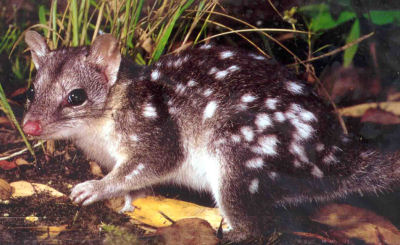
This is clear and obvious from the global population numbers through time that countries now overpopulated have become so fairly recently. How populations were able to control numbers locally is the subject of a book: S.M. Newman, Demography, Territory and Law: The Rules of Animal and Human Populations, Countershock Press, 2014.

Without going into the detail that it would entail as to how this worked, let's accept that most small communities in most countries have been disrupted especially in the last few centuries and mechanisms that worked for aeons have been corrupted.

Sustainable Population Australia has for the last few years been actively involved in a campaign to put the global population issue on agenda of the Intergovernmental Panel on Climate Change- (Note that 2 of the authors of the latest report have said that population growth and economic growth or development drive GGEs.) SPA’s is an ambitious and expensive enterprise which most of us cannot even contemplate, it seems that the best thing that the rest of us mortals can do is to come to grips intellectually with what has happened to bring us to the terrifying place we are now.
Age of extinctions

I say it is terrifying because we are in a great age of extinctions, with Australia leading the charge. Climate change seems to be a reality and a very dramatic one with unpredictable and far reaching consequences World hunger has not improved and the task of increasing food production for an even greater world population is, to say the least, extremely challenging and will no doubt mean further environmental degradation as crops and raising of animals for meat means land must be taken over for these purposes.
Oil
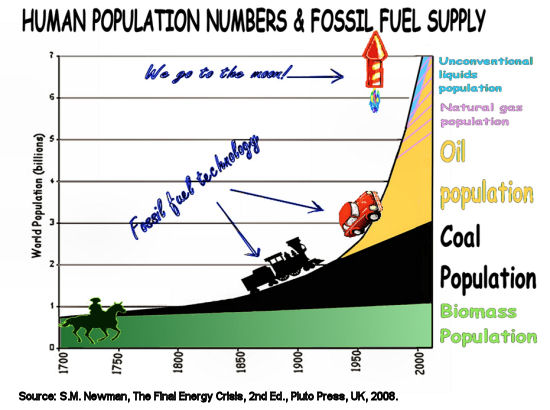
Finally, the liquid that fuelled the last few decades of world population growth, oil, is a finite resource and we’ve burnt a hell of a lot of it. The easy- to- obtain oil is dwindling; otherwise oil exploration companies would not be resorting to sources deep in sea beds or requiring elaborate practices to extract (shale oil) nor overriding property rights and democracy to extract coal gas.
When more energy is required to extract the substance than the amount of energy extracted it will be the end. I don’t know when that will be but it must be on the horizon. When this happens, it is not just a matter of us all converting to battery powered cars, it affects world food production. Since 2008 there have been riots over the cost of cooking fuel in poor countries where cars are hardly an issue.
It is said that “modern agriculture is the process of turning oil into food”.
Some also say on the subject of oil depletion that
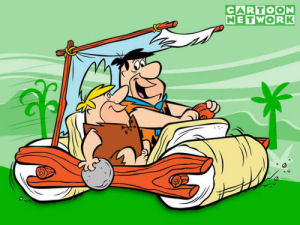
“The stone age didn’t end because they ran out of stones.”
This quip is to point out the ingenuity and inventiveness of the humans. But we cannot afford the luxury of such complacency. The situation is now perilous for millions if not billions of people if not enough food is produced. Already about one billion people are either hungry or under nourished.
Mass commercial agriculture also overturns local people’s capacity to provide food for themselves, by taking over land and patenting species of grain and other foods.

The world’s population needs to be allowed to decline and then stabilise at lower and safer levels as soon as possible to minimise human suffering. People need to have enough self-governing power to be able to veto the engineering of population numbers upwards by governments and big business. Compromising the environment for economic and population growth erodes human rights and then the humane treatment of other creatures becomes even less likely thus increasing total suffering.
This is an ethical issue.
NOTES
[1]The nation with the highest growth in the world is Qatar at 4.93% p.a. Lower growth countries are Denmark 0.24, Greece, 0.06, Italy, 0.38 and then some countries are not growing at all but their populations are falling- Russia -0.01, Japan -0.08, Cuba – 0.12 and Cook Islands -3.14. http://www.photius.com/rankings/population/population_growth_rate_2013_0.html
These figures are a bit rough as this site underestimates Australia’s growth rate, but the order of is most likely to be indicative.
[3] See, Newman, S.M., The Growth Lobby in Australia and its Absence in France, Research thesis in Environmental Sociology, 2002, Swinburne University.
[4] Newman, S.M., Demography, Territory, Law: Land Tenure and the Origins of Capitalism in Britain, Candobetter.net, forthcoming publication 2014, (Advance copy) p.112.


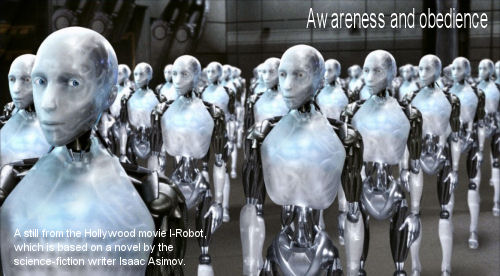 The problem is that once you entrust growth of the population and future direction to powerful individuals, whether in the government or in business, the ordinary people lose their right and ability to secure their own future. Having a system whereby a nation is subject to arbitrary population policy is a crime against that nation of people. Period. Policy which may influence birth rates through incentives or disincentives is different, as population in those cases is still determined by people’s individual reproductive choices. The future of a population of people is no longer in the hands of the people who share its future, but in those who may only see the people as a resource, or worse still, only see the state as a resource and people as merely human assets. People then become interchangeable and replaceable. A subtle, but very significant shift happens here. The identity of the people, the nation itself, the nation of people no longer exists in a political sense. The country has changed from being a tool of a people to organise themselves and to serve them, to a resource controlled by a few, whose make up is arbitrary and can be changed at will. All that matters now is numbers, and some will argue the population should be higher, others lower, but this is now all done from the perspective of the needs of the economy and the needs of the system. The people essentially hand themselves over and are now owned by state and government interests. Whether the state is a democracy or not, whether it has been popularly voted it or not doesn't matter. No individual should have the right to decide the fate of a people.
The problem is that once you entrust growth of the population and future direction to powerful individuals, whether in the government or in business, the ordinary people lose their right and ability to secure their own future. Having a system whereby a nation is subject to arbitrary population policy is a crime against that nation of people. Period. Policy which may influence birth rates through incentives or disincentives is different, as population in those cases is still determined by people’s individual reproductive choices. The future of a population of people is no longer in the hands of the people who share its future, but in those who may only see the people as a resource, or worse still, only see the state as a resource and people as merely human assets. People then become interchangeable and replaceable. A subtle, but very significant shift happens here. The identity of the people, the nation itself, the nation of people no longer exists in a political sense. The country has changed from being a tool of a people to organise themselves and to serve them, to a resource controlled by a few, whose make up is arbitrary and can be changed at will. All that matters now is numbers, and some will argue the population should be higher, others lower, but this is now all done from the perspective of the needs of the economy and the needs of the system. The people essentially hand themselves over and are now owned by state and government interests. Whether the state is a democracy or not, whether it has been popularly voted it or not doesn't matter. No individual should have the right to decide the fate of a people. Nelson Mandela is dead and, despite his immense charisma, intellect, capability and courage, Africa remains poor, divided, overpopulated and spectacularly unhealthy. In her monumental book,
Nelson Mandela is dead and, despite his immense charisma, intellect, capability and courage, Africa remains poor, divided, overpopulated and spectacularly unhealthy. In her monumental book, 
 Click for French tv coverage
Click for French tv coverage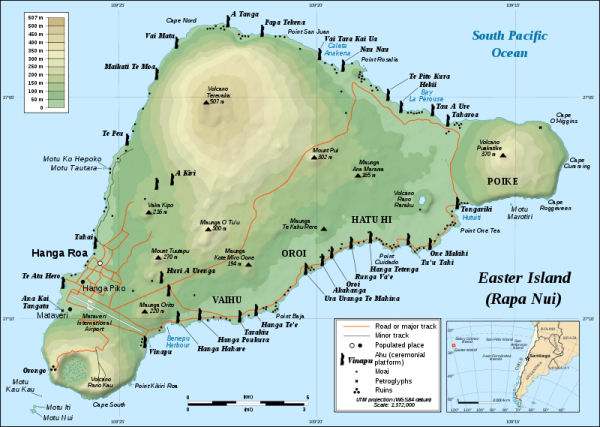

Recent comments